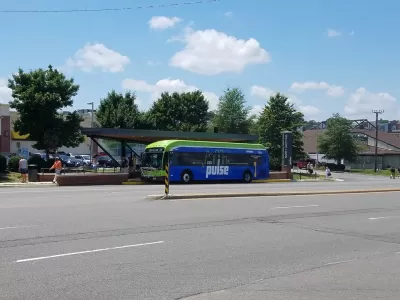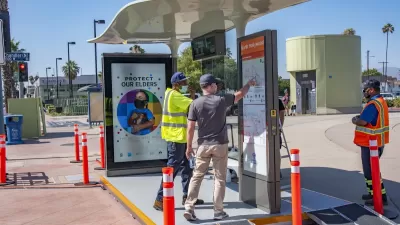The region’s transit agency plans to install new benches and shelters at as many as 75 percent of bus stops systemwide.

The Greater Richmond Transit Company (GRTC) has released a plan to add benches and shelters to some of its 1,609 bus stops, only 21 percent of which currently have a bench. As Wyatt Gordon writes in Greater Greater Washington, “According to the newly passed Essential Infrastructure Plan, starting next summer GRTC will begin installing 160 shelters and 225 benches over the next five years.”
Gordon notes that the agency would only reach 75 percent coverage with benches or shelters in their “aspirational” scenario, while the “attainable” plan would provide infrastructure at 50 percent of the system’s stops. “One of the biggest barriers to building out benches and shelters across the region was lifted earlier this year when the Virginia Department of Transportation finally approved GRTC’s proposed shelter style after an inexplicable two year plus delay.”
The project was prompted by the superior infrastructure provided along the Pulse bus rapid transit line, which led transit riders to demand similar improvements across the entire system—as Gordon puts it, “raised the bar on what many of the region’s residents consider acceptable stop infrastructure.”
Like other systems seeking to boost lagging ridership and ease the financial burden for its riders, the GRTC system went fare-free in 2020 and has extended free fares through June 2025.
FULL STORY: Shelters and benches for 75% of Richmond’s 1,609 bus stops? GRTC has a plan for that.

Alabama: Trump Terminates Settlements for Black Communities Harmed By Raw Sewage
Trump deemed the landmark civil rights agreement “illegal DEI and environmental justice policy.”

Planetizen Federal Action Tracker
A weekly monitor of how Trump’s orders and actions are impacting planners and planning in America.

The 120 Year Old Tiny Home Villages That Sheltered San Francisco’s Earthquake Refugees
More than a century ago, San Francisco mobilized to house thousands of residents displaced by the 1906 earthquake. Could their strategy offer a model for the present?

In Both Crashes and Crime, Public Transportation is Far Safer than Driving
Contrary to popular assumptions, public transportation has far lower crash and crime rates than automobile travel. For safer communities, improve and encourage transit travel.

Report: Zoning Reforms Should Complement Nashville’s Ambitious Transit Plan
Without reform, restrictive zoning codes will limit the impact of the city’s planned transit expansion and could exclude some of the residents who depend on transit the most.

Judge Orders Release of Frozen IRA, IIJA Funding
The decision is a victory for environmental groups who charged that freezing funds for critical infrastructure and disaster response programs caused “real and irreparable harm” to communities.
Urban Design for Planners 1: Software Tools
This six-course series explores essential urban design concepts using open source software and equips planners with the tools they need to participate fully in the urban design process.
Planning for Universal Design
Learn the tools for implementing Universal Design in planning regulations.
Clanton & Associates, Inc.
Jessamine County Fiscal Court
Institute for Housing and Urban Development Studies (IHS)
City of Grandview
Harvard GSD Executive Education
Toledo-Lucas County Plan Commissions
Salt Lake City
NYU Wagner Graduate School of Public Service





























